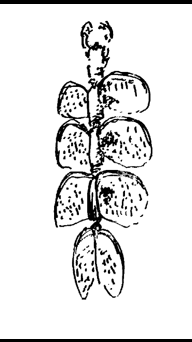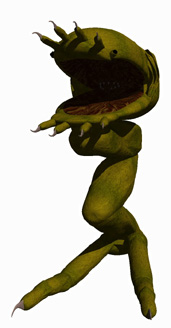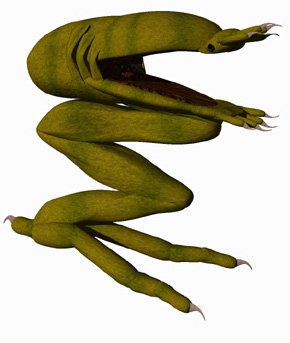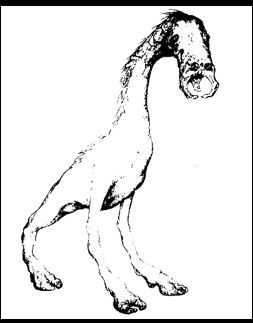Early Animals
Three important animals of this coastal ecosystem received an above average level of attention. The first was a flying communal organism named the "Segmented Dragonfly".
Communal is a word that is used advisedly, since although the entire creature is made up of five lesser creatures, these are no longer true individuals. The lesser creatures compose the "segments" and are linked end to end in a chain. Each one comprises a pair of wings, legs, ventral mouthparts and an individual intestinal tract and anus. The three center segments are similar and represent the basic building blocks of the super‑organism. The anterior segment has its wings evolved into a pair of manipulators for catching prey and the hind segment has the wings modified instead into a fused tailplane, akin to that on a WWI aeroplane. Food caught by the anterior segment is partially consumed and then passed underneath to the mouthparts of the next segment and so on down the line. Each mouth gets a bite, right along to the hind segment which is mostly inert tailplane and little living tissue. The segments therefore have separate blood supplies and process their food individually. Their main physiological connection is via the nervous system, which needs to be universal, so that the overall creature can coordinate itself.
There are many questions remaining about the Segmented Dragonfly. How does it reproduce? Might it be by dropping off a center segment that can then link with others, or grow new segments? How is its intelligence distributed? What are the advantages of such compartmentalization? How did it evolve in the first place. How well could the thing fly? Anybody who is interested might build on what we have, or invent an entirely new flyer.

The "Stinging Pouncer" represents the predator at the top of our ecosystem's food chain. It is a variant of a successful Genus more generally referred to as the "Springcroc" which we shall discuss here. In the figure are illustrated an early aquatic and later amphibious versions of the Springcroc. The Stinging Pouncer was a more specialized version of the basic model, streamlined for speed and equipped with a venomous lance.
The design of the Springcroc is totally different from any creature of Earth and, of all the inhabitants of Epona, has received the most attention to its internal, as well as external details. Its skeleton is rather like that of a bivalve shell, although very large -- several feet across. It is hinged at one end and reduced in weight by being cut by rows of windows that run across the animal, rather than from front to back. The structure therefore looks more like a basket, made from thick ribbing, with lid and container a similar size and articulating at a single, prominent joint. When upper and lower halves are closed, the Springcroc's body becomes a buoyant compartment that floats on the still lagoon waters. Attached to the lower shell is a single, strong, paddle‑shaped limb that can be tucked neatly into a shallow groove on the underside.
You can see from the figure that it has three joints and can unfold to a considerable length. The leg is endowed with powerful muscles with connections onto bony spurs on the lower shell and can thus be made to kick powerfully, allowing the Springcroc to surge forward in the water or to hop on land. It is not a method of locomotion designed for prolonged movement, however, and so the Springcroc hunts at a leisurely pace and kills in sudden bursts of activity. It does not have any jaws as we would know them, but possesses instead an "extensible" stomach. This functions rather like a frog's tongue in that it shoots out to snare its prey; only the Springcroc's organ is hollow and engulfs its victim. The muscular sack is snapped back into the shell which clamps shut both squeezing the prey and covering it with corrosive digestive juices, death by suffocation follows rapidly. (What happens after this is not clear -- whether the Springcroc has an anus, or ejects wastes back out of its mouth).
The creature's sense organs are arranged along the anterior rim of the upper shell. Mounted on stalks of various lengths, they consist of eyes, taste/smell organs that can be dipped into the water or waved in the air, and other items, such as the poisonous sting evolved by the Stinging Pouncer which was used to subdue larger prey than could be safely engulfed whilst still struggling.
Thus, we have quite a good alien in the Springcroc, but lots of gaps need to be filled in. For instance, somebody should try to redesign that leg, especially the foot, which looks much too frog‑like. Does the leg work at all -- could it hop like we say it does? We also need to decide on details of its digestion, reproduction etc. Also, how does it breathe? Does it have lungs or what?
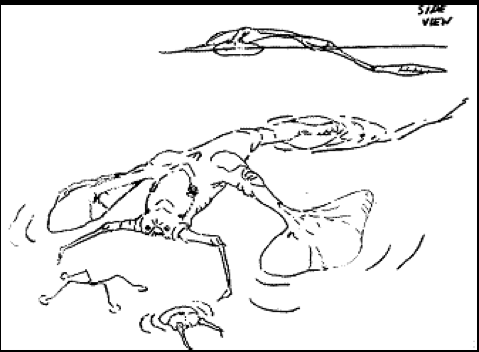
The star of the show however was the so‑called "Poncedonus" which was later evolved into the Ceretridon. (God knows where the name Poncedonus came from, but that's what is written on this viewgraph I have here -- unless someone's playing a joke or something! -- Martyn). Anyway, the figure to the left shows the humble origins of the Poncedonus as a dweller on the lagoon surface, floating on two pontoons.
It is a hunter, mid‑way up the food chain that feeds on creatures swimming just below the surface. It has five limbs: two protruding from the "head" which terminate in spikes designed for catching prey; two attached to the "thorax" which terminate in air‑filled pontoons; and a hind limb, which we might falsely recognize as a "tail." (The Poncedonus has no spinal column and therefore cannot have a tail in an earth‑like sense). The hind limb is equipped with a paddle which is brushed up and down, in the manner of a dolphin, for propulsion.
The Poncedonus is more capable at prolonged locomotion than the Springcroc, but is still predated upon by the larger beast if it gets too close. It has four eyes in two distinct pairs that are positioned according to their function. The larger pair look forward and downward and are used for general vision and for hunting. They are sophisticated, capable of forming detailed images and have polarizing filters to cut out glare from the water's surface. The smaller pair of eyes are more rudimentary and look upward; they are best at picking up motion and are used to spot aerial predators. The brain of the Poncedonus sits in a bony cavity behind the upper eyes and in front of the "ears" (tympanic membranes situated forward of the connection of the pontoon limbs with the body). There is apparently no gender division in the species: individuals lay eggs into a layer of particularly sticky mucous on another's back, between the two pontoon limbs, where they are fertilized and retained until the young reach to some unspecified stage of development.
At this early phase, the design of the Poncedonus was quite rudimentary. But of all the creatures invented for the lagoon community, it was the one for which a full evolutionary tree was developed. Its descendant, the Ceretridon is also incomplete and so, since both share the same body plan, we will reserve our list of outstanding questions until later.
Ready to find out more?
Epona's play continues
